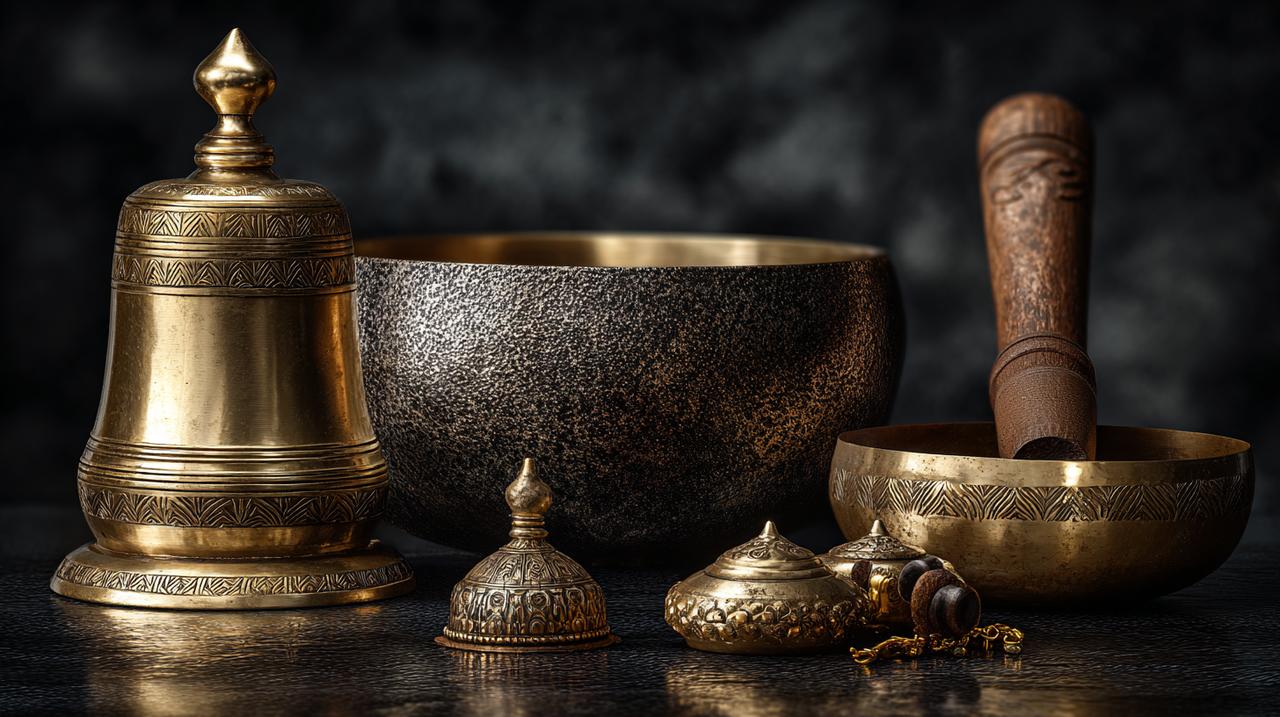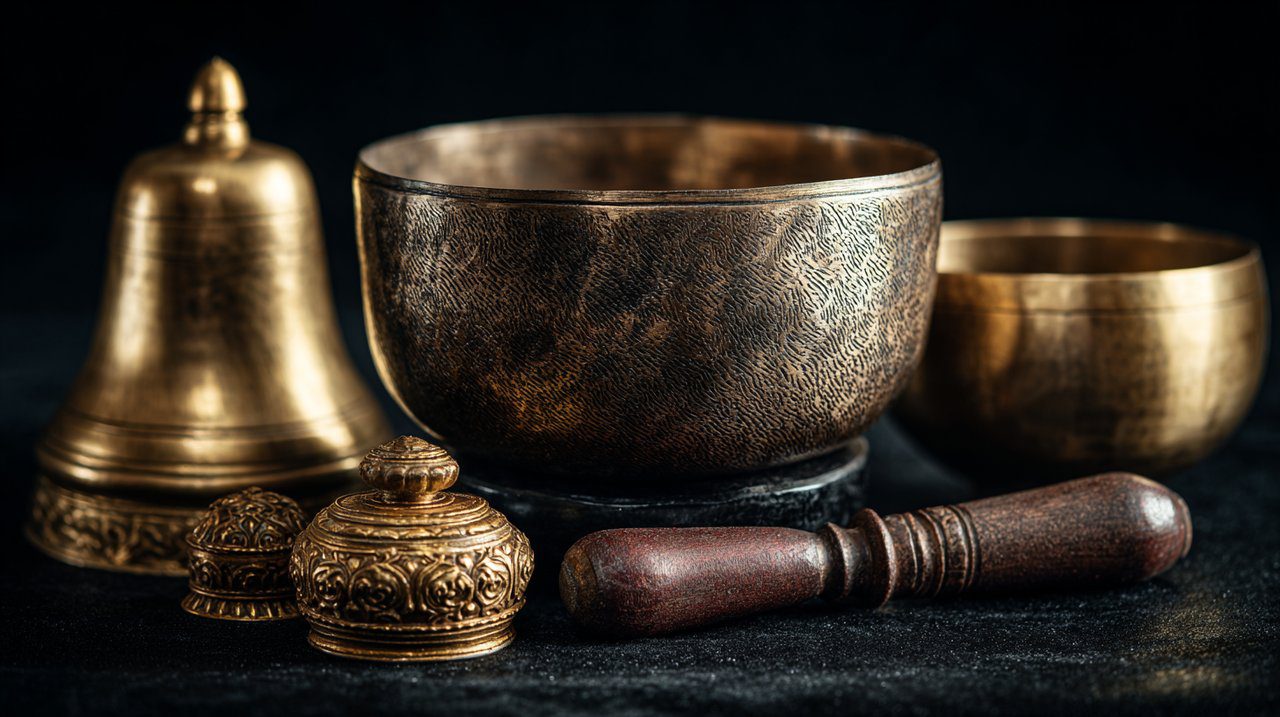Buddhist Bells: The Resonance of Stillness and Wisdom
In the gentle rhythm of our busy lives, finding a moment of true stillness can often feel like searching for a quiet whisper amidst a symphony of sound. Yet, within ancient wisdom, a profound path to inner calm has always been present, often revealed through the simplest, most resonant of means. Imagine the subtle, guiding power held within a single, clear tone. It is with a deep reverence for this power of sound that Buddhist bells emerge, not merely as beautiful objects, but as compassionate guides inviting us back to our own quiet center.

The Reverberating Legacy: Origins and Forms of Buddhist Bells
For centuries, Buddhist bells have offered their clear voices in monasteries and meditation halls, carrying the gentle whispers of ancient wisdom. These sacred instruments are so much more than mere tools; they are trusted companions on our path, each one thoughtfully crafted to awaken a specific quality of mind and invite a deeper connection to the quiet presence of the moment.
Ancient Roots and Sacred Purpose
The gentle lineage of Buddhist bells traces its origins to the heart of ancient India, later flourishing in the majestic highlands of Tibet and the serene valleys of Nepal. In these sacred lands, they were never simply musical instruments. Instead, they became vital threads woven into the fabric of ritual and meditation, guiding practitioners through ceremonies and moments of deep contemplation.
The purpose of these bells extends far beyond the sound they produce. They are imbued with a profound significance, inviting us to listen more deeply—not just to the beautiful tones, but to the wisdom that resonates within our own inner landscape.
Diverse Forms and Unique Voices
The family of Buddhist bells is wonderfully rich and varied, with each form offering its own unique voice and a special invitation to mindfulness:
- The Ghanta, often held alongside a Vajra (dorje), beautifully embodies the sacred union of wisdom (represented by the bell’s clear sound) and compassionate action (symbolized by the dorje). Its pure, resonant tone often gently marks the beginning and end of our practices, or significant moments within sacred rituals, serving as a steadfast anchor for our focused intention.
- Singing bowls, with their deep, sustained vibrations, are cherished for their ability to guide us into profound states of relaxation and meditative awareness. Their sound gently permeates the space, inviting a deep sense of calm and a subtle energetic cleansing, much like a gentle wave washing peacefully over the shore.
- Tibetan wind bells, with their spontaneous, gentle melodies, offer a constant, subtle reminder of impermanence and the beauty of the ever-present moment. When hung in sacred spaces or near a window, each passing breeze becomes an invitation to mindfulness, a soft chime that lovingly calls us back to the now.
- Tingshas, small, hand-held cymbals, produce a beautifully sharp, clear tone. They are often used to gently clear the mind, signal transitions between practices, or mark the beginning and end of meditation sessions, bringing an immediate sense of presence and crisp focus.

For those who feel called to embody the profound union of wisdom and compassionate action, a complete Bell and Dorje set can become a cherished tool. This sacred pairing allows us to fully engage with the beautiful symbolism of Prajnaparamita (wisdom) and Karuna (compassion), gently deepening our meditation and ritual practices.
The Resonance of Stillness: Healing and Purification Through Sound
Beyond their sacred ritualistic roles, the sounds of Buddhist bells hold an inherent capacity to gently influence our inner landscape. The subtle vibrations they emit can lovingly shift our state of being, inviting a profound sense of harmony and renewal. It is truly a gentle call, guiding us back to our natural, inherent state of peace.
Vibrational Harmony for the Mind
The gentle embrace of sound offers a profound journey into our inner landscape. The sustained, resonant tones of Buddhist bells, especially singing bowls, are like a tender invitation to our nervous system. They lovingly encourage states of deep relaxation and meditative awareness, softly guiding the incessant chatter of the mind towards a profound sense of inner peace. It’s a gentle invitation for the nervous system to settle and find equilibrium, much like a calm breath after a long day.
This deep connection between sound and our inner state is also profoundly explored in the practice of Buddhist chanting, which offers another pathway to spiritual insight and peace What is the True Significance of Buddhist Chanting?.
Energetic Cleansing of Space
Just as a room can sometimes feel heavy with unmoving air, our living spaces can subtly gather a certain unseen weight. The clear, resonant tones of Buddhist bells are believed to gently stir and purify these atmospheres, creating an environment that breathes with clarity and peaceful presence.
Imagine these sound waves as a soft, cleansing breeze, lovingly sweeping through your space. They invite freshness and lightness, preparing a sacred ground for your practice or simply for moments of quiet reflection. This isn’t about invoking a mysterious force; it’s about consciously cultivating an inviting and harmonious environment for your deepest being.

Spiritual Symbolism and a Guided Practice of Presence
Each Buddhist bell carries not only a beautiful sound but also a profound spiritual symbolism, gently echoing the core tenets of Buddhist philosophy. Understanding these deeper layers can truly enrich your connection to the instrument and your practice, transforming a simple object into a powerful, living reminder of your own inner wisdom. To truly grasp the essence of these tenets, it’s insightful to delve into the life and teachings of the one who laid their foundation Who Was the Buddha? A Guide to His Life and Wisdom.
Echoes of Wisdom and Compassion
In Tibetan Buddhism, the bell (ghanta) often represents Prajnaparamita, the perfection of wisdom, especially the profound wisdom of emptiness. Its hollow form gently signifies this emptiness, tenderly reminding us of the transient nature of all phenomena. The sound itself, which beautifully arises and then gracefully fades, illustrates this very impermanence.
The clapper, or tongue, of the bell symbolizes Karuna, representing compassion and skillful means. When the clapper strikes the bell, it signifies the sacred union of wisdom and compassion—the very essence of the awakened mind. This profound symbolism invites us to lovingly cultivate both deep insight and boundless kindness in our daily lives.
The bell’s clear tone is a gentle invitation to remember that true peace emerges from the harmonious union of wisdom and compassion within our own hearts.
A Moment of Presence: A Guided Practice
Now, I lovingly invite you to engage directly with the wisdom of these beautiful bells. If you have a small bell or even a Tibetan wind bell nearby, please join me in a brief practice. If not, simply close your eyes and allow your imagination to gently guide you:
- First, take a gentle, settling breath. Feel your feet on the ground, or your body resting in your seat. Allow a sense of presence to softly arrive.
- If holding a bell, feel its weight in your hand. Notice its texture, its temperature. Allow your senses to fully engage with this object, gently bringing your attention to the present moment.
- Now, with intention and a deep sense of gentleness, strike the bell softly. Do not rush this moment. Allow the sound to emerge naturally, without any force.
- As the sound begins to resonate, resist the urge to intellectualize or analyze it. Instead, simply become the sound. Let it lovingly wash over you, move through you. Feel its subtle vibrations, perhaps in your hand or in the air around you, allowing them to gently settle your entire being.
- Listen intently as the sound gradually fades, becoming softer and softer, until it gracefully dissolves into silence. Do not chase it. Simply observe its natural decay, its journey from presence to stillness.
- When the sound is completely gone, notice the silence that remains. What quality does this silence hold for you? Is there a sense of spaciousness, a quiet stillness within you? This is the moment of pure presence, unburdened by thought or external noise.
- Stay with this stillness for a few breaths, allowing yourself to simply be. This gentle act, repeated with intention, can cultivate profound inner peace and a deeper connection to your own quiet wisdom.
Integrating Stillness: Micro-Rituals for Daily Life
The profound wisdom of Buddhist bells is not confined to formal meditation sessions. Their gentle presence can beautifully weave moments of mindfulness into the very fabric of your everyday life, lovingly transforming the mundane into the sacred. By creating these ‘micro-rituals,’ we open ourselves to inviting peace into every corner of our existence.
Sacred Spaces in Modern Living
Consider placing a Tibetan wind bell near a window in your home or office. Its spontaneous melodies, lovingly carried by the breeze, can serve as a gentle reminder to pause, breathe, and return to the present moment. Each soft chime becomes a tender anchor, grounding you amidst the day’s activities.
You might also use a small hand bell to mindfully mark transitions: the start of your workday, a serene break for tea, or the evening’s gentle shift into rest. Each chime, consciously heard, can become a sacred punctuation mark in your busy day, inviting focus and profound calm.
Choosing Your Sacred Instrument
When you are ready to select a Buddhist bell for your home or practice, allow yourself to consider its resonance with your deepest intentions. Listen mindfully to its sound; does it evoke a sense of peace, clarity, or spaciousness within you?
Pay close attention to the craftsmanship, as a well-made bell often carries the beautiful intention and reverence of its maker. Whether it’s a robust singing bowl, a delicate Tibetan wind bell, or a crisp pair of tingshas, choose an instrument that truly resonates with your spirit and lovingly supports your journey towards inner calm and awareness.
From their ancient origins to their gentle presence in our modern lives, Buddhist bells offer a tangible and compassionate pathway to cultivate inner peace and presence. They invite us to listen deeply—not just to the sound itself, but to the profound silence and stillness it reveals within.
By embracing these sacred instruments, you invite a powerful yet gentle guide into your life, one that continually points you towards the quiet wisdom that resides within your own heart. Just as we began by seeking stillness amidst the hum of life, these bells remind us that peace is always accessible, waiting patiently for our mindful attention. Consider how a cherished Buddhist bell might serve as a beacon of tranquility in your daily practice, bringing that cherished whisper of stillness into vibrant presence.
💡 Frequently Asked Questions
Buddhist bells are ancient instruments that have resonated through monasteries and meditation halls for centuries. They serve as sacred guides and companions on the path to awakening, intended to evoke specific qualities of mind and guide practitioners through rituals and deep contemplation, imbued with spiritual significance.
The article mentions several types: Ghanta (often paired with a Vajra, representing wisdom and compassionate action, marking practice beginnings/ends); Singing bowls (known for inducing deep relaxation and meditative awareness through sustained vibrations); Tibetan wind bells (offering a subtle reminder of impermanence and inviting mindfulness); and Tingshas (small cymbals used to clear the mind, signal transitions, or mark meditation sessions).
The sustained tones of Buddhist bells, especially singing bowls, can encourage brainwave states associated with deep relaxation (like alpha and theta waves), helping to quiet the mind and foster inner peace. They are also believed to break up stagnant energetic patterns in living spaces, purifying the environment and creating an atmosphere conducive to clear thought and peaceful presence.
In Tibetan Buddhism, the Ghanta (bell) often represents Prajnaparamita, the perfection of wisdom, particularly the wisdom of emptiness. Its hollow form signifies emptiness, and its sound, which arises and then fades, illustrates the transient nature of all phenomena. The clapper symbolizes Karuna (compassion), and striking the bell signifies the union of wisdom and compassion, leading to enlightenment.
Buddhist bells can be integrated into daily life by placing a Tibetan wind bell near a window to serve as a gentle reminder to pause and return to the present moment. A small hand bell can also be used to mark transitions throughout the day, such as the start of work, a tea break, or the evening's transition into rest, helping to ground oneself amidst daily activities.








